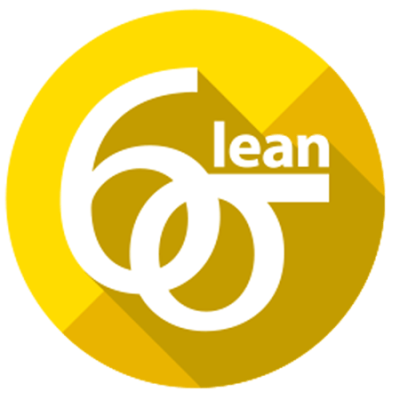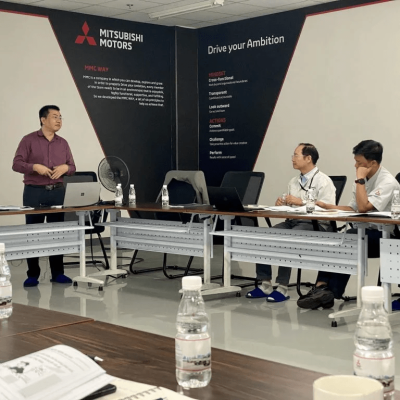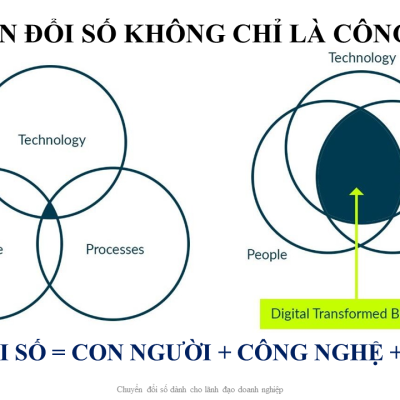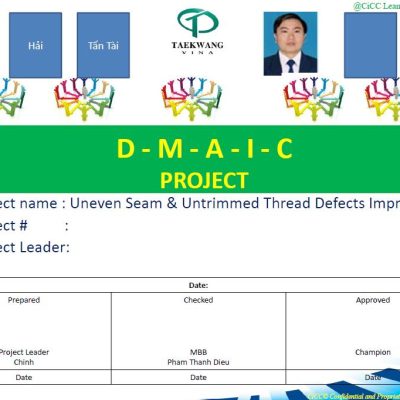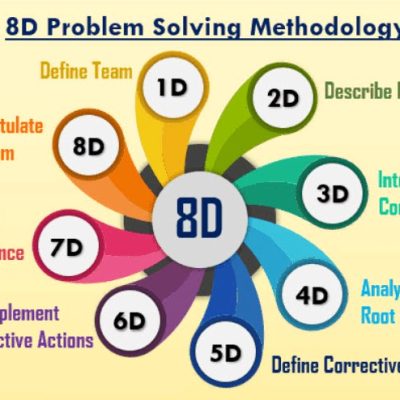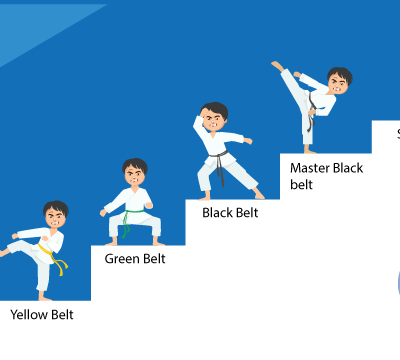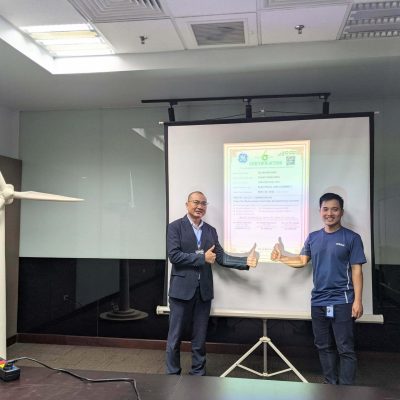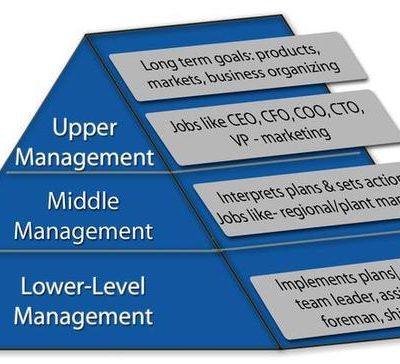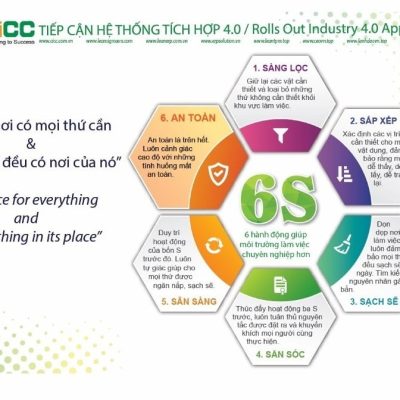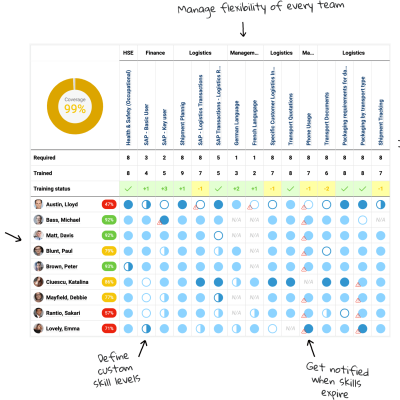Mô tả
Khóa học Lean Six Sigma Green Belt của CiCC là một chương trình đào tạo chuyên sâu về các phương pháp tối ưu hóa quy trình sản xuất và quản lý chất lượng dựa trên phương pháp Lean và Six Sigma. Với khóa học này, học viên sẽ được học cách tối ưu hóa quy trình sản xuất, giảm thiểu lãng phí, tăng cường năng suất, nâng cao chất lượng sản phẩm và tăng sự hài lòng của khách hàng.
Green Belts are employees of an organization who have been trained on the Lean Six Sigma improvement methodology and will lead a process improvement team as part of their full‐time job. There is more time spent on the decision‐making and strategy‐building components of key elements in the Lean Six Sigma project planning process. They have a deeper understanding of the overall process; they work with centralized project managers on delivering feedback and driving performance goals.
The program “Lean Six Sigma Green Belt” is designed for CNC VIETNAM to provide the knowledge and technical to using Lean Six Sigma tools and how to use Minitab software to collect data, analyze data and decision‐making on data fact.
Have overall picture and a roadmap for successful implement and application of Lean Six Sigma method. It also provides company’s key staff the ability to apply the appropriate tool for Lean Six Sigma Project of continuous improvement in their respective areas.
According to DMAIC roadmap to do Lean Six Sigma project. Program length: 8 days’ conduct in 6 weeks with each 2-1-1-2-1-1 of in-house training. Through each time the participants can apply what they learned in actual work. In this way participants can learn more about project management skills, role and responsibility to help and support improvement team member.
Method:
Construct full theory education program, included of : Theory, Example, Exercise, Question & answer
Divide session by each phase and time for training equal with morning and afternoon section
The main objectives of the program can be provided and training in classrooms, besides that participants will be understood the practical problems and potential solution through actually application Lean Six Sigma project in their workplace. Key objectives are described below
- Beinga Lean Six Sigma Green Belt level, know how to manage, lead team, responsibleforyourself implementationandsuccessofimprovementproject.
- Implementorparticipatein Lean Six Sigma Green Belt projectsto improveoverallproductivity, quality and deliverreal benefitsfor
- Apply Lean Six Sigma toolsonspecific situation and usingsoftware of statisticalas Minitab, Process mapping as Visio, Planningandproject management as MS
Note: Certification as a Lean Six Sigma Green Belt requires successful completion of this course, a passing grade on the final examination, and submission of a detailed report of 01 successful project.
Detail of Course Outline:
| Phase | Module | Name | Topics | Tool | Time |
| Overview and Recognize | 01 | Lean Six Sigma Break Thought Strategies | • What are Lean, Lean Six Sigma, and Lean Six Sigma?
• The Effects of Eliminate Wastes and Reduced Variation • Driving out Defects and Non Value Activities • Process Effectiveness vs. Efficiency • Translating Customer Needs into Requirements • The Lean Six Sigma Breakthrough Strategy • Lean Six Sigma Roles • Lean Six Sigma Storyboard (D-MAIC) | PC
Projector | Day 1
Morning 8:30 – 12:00 |
| 02 | Recognize Phase | • Pipes and Puddles – What’s the Process?
• The Customer’s Perspective • Determining How Well the Process Satisfies Customers • Process Boundaries • SIPOC and IPO Diagram • Identifying Improvement Opportunities • Value Stream Mapping | PC
Projector Visio | Day 1
Afternoon 13:30 – 16:30 | |
| Define Phase | 03 | Define Phase | • Clearly define what the customers care about.
• Define the Lean Six Sigma Project: • Description of the work process to be improved • Problem Statement (using measures of customer care-about) • Project Objective (improve meeting customer care-about by how much?) • The project plan | PC
Projector | |
| 04 | Calculate project benefit and effective | • What is Cost of Poor Quality (COPQ)?
• Quality Cost Categories • Estimating Cost Savings for a Lean Six Sigma Project • Hard vs. Soft Costs | PC
Projector | Day 2
Morning 8:30 – 12:00 | |
| Measure Phase | 05 | The Power of Data | • Why Use Data
• The Role of Statistics • Variable Data / Continuous Data • Attribute Data / Discrete Data • Levels of Knowledge | PC
Projector | |
| 06 | Continuous Data | • Descriptive versus Inferential Statistics
• Characterizing Data Sets: • Shape of Distribution • Central Tendency (Mean, Median, Mode) • Variation (Range, Standard Deviation, Variance) • Dotplots • Histograms • Boxplots • Normal Distribution | PC
Projector Minitab Excel | ||
| 07 | Discrete Date | • Defects versus Defective Items
• Counting Defective Items • Parts per Million (PPM) • Counting Number of Defects • Defining Opportunities • Defects per Million Opportunities (DPMO) • Defects per Unit (DPU) • Rolled Throughput Yield (RTY) • Process Capability Metrics | PC
Projector Minitab Excel | Day 2
Afternoon 13:30 – 16:30 | |
| 08 | Data Collection Plan | • What is Data?
• Why is Data Collection Important? • Sampling Strategies • Strategy for Process Baselining • Collecting Data Effectively • Creating a Checklist • Graphing the Data and Graphical Toolbox • Pie Chart, Stacked Bar Chart, Pareto Diagram, Pareto Chart Interpretation, Time Series Analysis | PC
Projector | ||
| 09 | Measuring Process Behavior | • Determining What to Measure
• Extracting Knowledge from Data • Understanding Types of Variation • Process Behavior Charts for Variable Data: • I & mR Chart • X Bar and R Chart • Process Behavior Charts for Attribute Data: • p Chart • u Chart • Interpreting Process Behavior Charts | PC
Projector Minitab Excel | Day 3
Morning 8:30 – 12:00 | |
| 10 | Sigma Level | • When evaluating current level (baseline) of how well the process meets customer care-about.
• To quantify Improvement in the process performance | PC
Projector Minitab | ||
| 11 | Pareto Analysis | • What is a Pareto Diagram?
• Constructing a Pareto Diagram • Interpreting a Pareto Diagram • Uses of Pareto Diagrams | PC
Projector Minitab | ||
| 12 | Process Capability | • What is Process Capability
• Process Capability from Variable Data • Estimating Percentage Beyond Specification Limits • Cp, Cpk, Pp Ppk Indices • Process Capability from Attribute Data | PC
Projector Minitab | ||
| Analyze Phase | 13 | Analyze cause and Effect C&E and C&E Matrix | • Comparing the C & E Diagram and the C & E Matrix
• What is a Cause and Effect Diagram? • Conducting Cause and Effect Analysis Using the Diagram • Constructing a Cause and Effect Matrix • Verifying Causes • Evaluating KPIVs | PC
Projector Minitab | Day 3
Afternoon 13:30 – 16:30 |
| 14 | Failure Mod Effect Analyze FMEA | • Risk Management Roadmap
• Risk Treatment Planning • What is FMEA? • Objectives of FMEA in Lean Six Sigma • When to use FMEA • FMEA Steps • FMEA “Tips” • FMEA Exercise | PC
Projector | ||
| 15 | Analyze of Correlation and Regression | • What is a Correlation?
• Scatter Diagram • The Correlation Coefficient, r • Regression Analysis • The Coefficient of Determination, R2 • Adjusted R2 • Overall Significance • Why Use a Regression Equation? | PC
Projector Minitab Excel | Day 4
Morning 8:30 – 12:00 | |
| 16 | Cause Verification | • Why Verify Causes?
• Methods for Verifying Causes • Creating the Plan to Verify Causes • Probability Theory • Types of Distribution, Normal Distribution, Binomial Distribution, Poisson Distribution • Data World Used for Inferential Statistics, Statistical Interference • Context for Inferential Statistics, Point and Interval Estimates, Central Limit Theorem, Interval Estimates | PC
Projector | ||
| • Hypothesis Testing (Step by step)
• Parametric Tests • Anderson Darling Normality Test • Equality of Variance Test • 2 Sample T-Test • Paired T-Test • Test for Two Means • Analysis of Variance (ANOVA) • Non-Parametric Tests • Mann-Whitney Test • Kruskal-Wallis Test • Mood’s Median Test • Categorical Data Analysis • 2 Sample P-Test • Chi-Square Test for Independence • Correlation and Regression • Coefficient of Correlation (Pearson’s R) • Regression Modeling • Updating of Project Storyboard (Analyze Phase) • Presentation and Approval of Analyze Phase to Sponsors and Stakeholders | Day 4 Afternoon 13:30 – 16:30 | ||||
| 17 | Detailed Process Mapping | • Process Mapping in Measure, Analyze and Improve Phases
• Steps for Creating Detailed Process Map • Identify Non-value-added Steps • Analyze the Map • The “Should Be” Map
| PC
Projector Visio EVSM | ||
| Improve Phase | 18 | Identified solution for Improvement | • Counteract Causes
• What is a Counteraction? • Brainstorming Counteractions • Evaluation Matrix | PC
Projector | Day 5
Morning 8:30 – 12:00 |
| 19 | Optimize Process Flow | • “To Be” Process Map
• Improve Phase Roadmap • Cost Reduction Principle • Phases of Lean Office • Customer Demand • Takt and Pitch Calculation • Buffer and Safety Resources • 5S for the Office • Continuous Flow | PC
Projector Visio | Day 5 Afternoon 13:30 – 16:30 | |
| • Poka-Yoke (Mistake Proofing)
• Kanban and FIFO • Standardized Work • Work Balancing • Leveling • Capacity Leveling • Visual Management for Leveling | PC
Projector Visio | Day 6
Morning 8:30 – 12:00 | |||
| • Identification of Appropriate Solutions based on validated Root Causes
• Checking of Effectiveness of the Actions Taken • Verification/Realization of the Benefits (before and after comparison) • Updating of Project Storyboard (Improve Phase) • Presentation and Approval of Improve Phase to Sponsors and Stakeholders • Introduction DOE | PC
Projector Visio | Day 6 Afternoon 13:30 – 16:30 | |||
| Control Phase | 20 | Control Plan | • What is a Control Plan?
• Control Plan Strategy • What to Control? • Identifying KPIVs • Why Use a Control Plan? • Developing a Control Plan • Choosing the Right Level of Control • Components of a Control Plan • Control Plan Worksheet | PC
Projector | Day 7 Morning 8:30 – 12:00 |
| 21 | Standardization | • How to Control the Xs
• What is Standardized Work? • What is a Standard? • Why Standards are Needed • 5S and Visual Controls • Sharing Best Practices | PC
Projector | Day 7 Afternoon 13:30 – 16:30 | |
| 22 | Error Proofing | • What is Error Proofing?
• Errors->Mistakes->Defects • Some Benefits of Error Proofing • Why use Error Proofing? • The Quest for Zero Defects • Error Proofing Principles • Common Causes of Errors / Mistakes • Controlling Sources of Error • Error Proofing Inspection Techniques • Implementing Error Proofing | PC
Projector | ||
| 23 | TPM | • Total Productive Maintenance
• Some common types of maintenance • Introduction to TPM • Implementing TPM and what are the benefits? • | PC
Projector | Day 8 Morning 8:30 – 12:00 | |
| Review and Finish
| 26 | Review and examination | • Question and answer
• Review Lean Six Sigma knowledge • Review and Edit Team’s presentation • Examination Lean Six Sigma Green Belt | PC
Projector | Day 8 Afternoon 13:30 – 16:30 |
| 27 | Projects Presentation | • Projects leader and Team present to management | PC
Projector |
Participant:
- Who are responsible for adopting, implementing, maintaining and developing continuous improvement in company
- Who are selected to become Lean Implementer or Green Belt / Black Belt Lean Six Sigma
Program Cost: Contact us for Quotation
Note: This cost is including Accommodation, Travel, Training material, Certificate.
Number of participant:
Arrange by customer, but to good maintain classes, number of participant should be not excess 25 people.
Introduction Consultant Profile:
MBB. PHAM THANH DIEU – LEAN6SIGMA, SCM, BSC, LeanERP CONSULTANT
Telephone: 098. 8000. 364, email: dieu.pham@cicc.com.vn, Master Black Belt and Lean6sigma group leader (Lean6sigma Vietnam Network) www.lean6sigma.vn , Owned forum, www.leansigmavn.com , Chairman and Director of Continuous Improvement Consulting JSC; www.cicc.com.vn . With more than 15 years fulltime working, training and consulting in field of continuous improvement Lean, LeanTPM, Six Sigma, Lean6sigma, Supply Chain and Balance Scorecard and LeanERP system.
Besides he was a collaborator Lean6Sigma network bulletins, the magazine of Vietnam Supply Chain Insight, The Saigon Times, and numerous magazine and other online forums. Some customer Dieu has been consulting and training for application and deployment Six Sigma, Lean, LeanTPM, Lean6sigma such as ANZ VN Bank, Bunge VN, YKK VN, HYOSUNG, KOTOBUKI VN, CS Wind VN, SPi Global, Posco VN, Spatronic VN, Kimberly Clark VN, Nitto Denko VN, Vinamilk, Trung Nguyen Coffee, Olam Café VN, Chantelle VN, Datalogic Scanning VN, Pepperl-fuchs VN, Rang Dong Plastic, Crucialteck Electronic, Thanh Nhon JSC, HUDA Beer, Vinh Khanh Cable-Plastic, Saigon Cable, Tan Tien Packaging, Kosvida, Van Nga Packaging, SOVI Packaging, Starprint VN, Vinh Long Food, and many other clients can refer www.cicc.com.vn for detail.
Professional capability:
Dieu has extensive experience in coaching, training & implementation Lean6Sigma and other continuous improvement tools. Flexibility, enthusiasm and patience is the virtue of his to help organization introduce and promote better understanding of the theory and application Lean6Sigma and organizations enables to manage and operate an effective the production of their business. He has very deep understanding of the principles Lean6Sigma and change management system from traditional manufacturing and services to Lean6Sigma production services. He approached Lean, Six Sigma, Supply Chain, and Balance Scorecard from sitting in a chair at the school and pursued until now. Dieu has practical experience working on large Lean6Sigma global company as: Mr. Dieu worked at Samsung Electronics Corporation in 2002 – 2004, the company specializes in electrical and electronic products owner by Korea have successfully applied the Six Sigma management system since 1997, at that time Mr. Dieu has responsible for improving the full time in Six Sigma department, he has completed the program Green Belt and Black Belt at Samsung. In 2004-2005 he joined the group’s fourth-largest wholesaler Metro Cash & Carry, he was responsible for the assessment and selection of suppliers and ensure quality of goods imported into the Metro Store for non-food products bearing its own brand of Metro, and he has completed courses in Supply Chain Systems here and some soft skill else.
From 2005 – 2007 he joined the Johnson Control Corporation, is a rich and powerful corporations in the Top 100 U.S. entrepreneurs are specialized inside, interior systems and batteries for cars, in this time Mr. Dieu is the head of continuous improvement department, is responsible for establishing and maintaining system improvement through the introduction and implementation of Lean6Sigma, he has completed extensive training courses on application deployment Lean6Sigma in Malaysia, completion Study Master Black Belt.
From 2007 – 2009 he spent so much time to research the application of continuous improvement in Viet Nam enterprise with Lean6Sigma during the time he worked for FPT corporation, where he was responsible for research and introducing Lean6Sigma for the whole group, formulate strategies and implement plans Lean6Sigma, recruitment, training and advice to member companies in the group, building structure and standards to guide improvements continue. From 2009 – 2010 he joined in Government Organization is Quality and Testing Center 3, he is Head of Lean6sigma Department.
Up to now, Dieu and other consultants established and build up the Continuous Improvement Consult Joint Stock Company (www.cicc.com.vn ), he is a Chairman and Deputy Director. His Company becomes a partnership with Hirayama Japan, American Society for Quality (ASQ-AUTO), Robinson Consulting Group (USA), URS (Korea) Micon Thailand, Lean6sigma Vietnam Network, and Supply Chain Insight.







